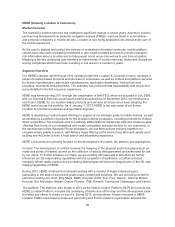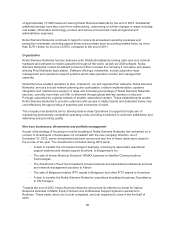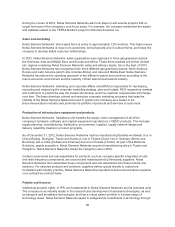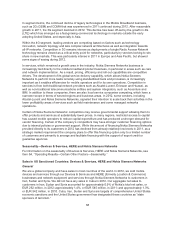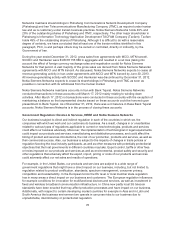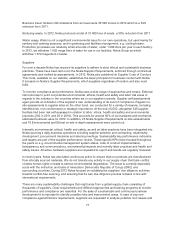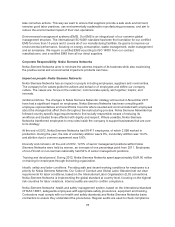Nokia 2012 Annual Report Download - page 69
Download and view the complete annual report
Please find page 69 of the 2012 Nokia annual report below. You can navigate through the pages in the report by either clicking on the pages listed below, or by using the keyword search tool below to find specific information within the annual report.In segment terms, the continued decline of legacy technologies in the Mobile Broadband business,
such as 2G (GSM) and CDMA that was experienced in 2011 continued during 2012. After reasonable
growth in 2011, the 3G segment declined in 2012. This decline has been off-set by the growth in 4G
(LTE) which has emerged as a fast-growing commercial technology in markets outside the early
adopting United States, and especially in Asia.
Within the 4G segment, leading vendors are competing based on factors such as technology
innovation, network topology and less complex network architectures as well as integration towards
all-IP networks. Competition in 3G remains intense as deployments of single Radio Access Network
technology remains viewed as a critical entry point for networks, particularly by vendors looking to win
share in new markets. This was particularly intense in 2011 in Europe and Asia Pacific, but showed
some signs of easing during 2012.
In services, which remained a growth area in the industry, Nokia Siemens Networks business is
increasingly tied directly to the mobile broadband product business, in particular in areas such as care
and network implementation. As a result, pricing, efficiency and roll-out capabilities are competitive
drivers. The development of its global service delivery capability, which allows Nokia Siemens
Networks to perform more tasks remotely using standardized tools and processes, is increasingly
important as it enables efficiencies for mobile operators and for its own operations. Competition in
services is from both traditional network providers such as Alcatel-Lucent, Ericsson and Huawei, as
well as non-traditional telecommunications entities and system integrators, such as Accenture and
IBM. In addition to these companies, there are also local service companies competing, which have a
narrower scope in terms of served regions and business areas. In 2012, some vendors, including
Alcatel-Lucent and Nokia Siemens Networks, signaled their intention to scale back their activities in the
lower profitability areas of services such as field maintenance and some managed networks
operations.
Certain of Nokia Siemens Networks’ competitors may receive governmental support allowing them to
offer products and services at substantially lower prices. In many regions, restricted access to capital
has caused mobile operators to reduce capital expenditure and has produced a stronger demand for
vendor financing. Certain of the company’s competitors may have stronger customer financing options
due to internal policies or government support. While the amount of financing Nokia Siemens Networks
provided directly to its customers in 2012 has declined from already relatively low levels in 2011, as a
strategic market requirement the company plans to offer this financing option only to a limited number
of customers and primarily to arrange and facilitate financing with the support of export credit or
guarantee agencies.
Seasonality—Devices & Services, HERE and Nokia Siemens Networks
For information on the seasonality of Devices & Services, HERE and Nokia Siemens Networks, see
Item 5A. “Operating Results—Certain Other Factors—Seasonality.”
Sales in US Sanctioned Countries: Devices & Services, HERE and Nokia Siemens Networks
General
We are a global company and have sales in most countries of the world. In 2012, we sold mobile
devices and services through our Devices & Services and HERE (formerly Location & Commerce)
businesses and network equipment and services through Nokia Siemens Networks to customers in
Iran, Sudan and Syria. We did not have any sales in Cuba in 2012. Our aggregate net sales to
customers in Iran, Sudan and Syria accounted for approximately 0.9% of Nokia’s total net sales, or
EUR 262 million, in 2012; approximately 1.4%, or EUR 545 million, in 2011; and approximately 1.3%,
or EUR 542 million, in 2010. Cuba, Iran, Sudan and Syria are targets of comprehensive United States
economic sanctions and the United States government has designated these countries as “state
sponsors of terrorism.”
68




